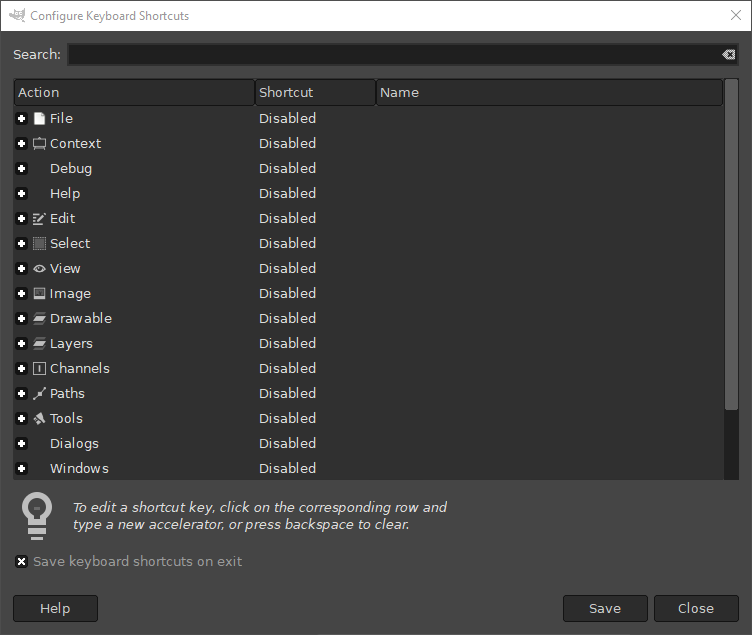The Keyboard Shortcuts Dialog allows you to change or add a keyboard shortcut to a menu command, a tool, filter, etc.
You can access it:
-
from the main menu: → ;
-
or, from the User Interface Preferences: click the Configure Keyboard Shortcuts… button.
If you already know for which command you want to change the keyboard shortcut, then you can use the Search field to enter it. This will shorten the list of possible commands to only those that contain the text you searched for.
The center area of the dialog shows the action categories on the left.
You can expand a category by pressing the
icon in front of it,
and collapse it by pressing the icon again. Each expanded
action category will show a list of available actions.
The middle column shows which Shortcut is assigned to each action, or
“Disabled” when the action doesn't have a Shortcut. The
“Name” column shows the name by which GIMP knows the
action.
All actions that can be assigned a shortcut are divided into categories. Each menu has a category that corresponds with its name, and all scripts and plug-ins are sorted into categories based on the first part of their name.
![[Tip]](images/tip.png)
|
Tip |
|---|---|
|
To increase the amount of visible actions, you can resize the dialog to your liking. |
Figure 15.122. Assigning a keyboard shortcut

The “New accelerator…” text in the Shortcuts column shows that GIMP is waiting for a new shortcut to be entered for the Add Alpha Channel action.
When you have found the action you want to set a shortcut for, click on the line that shows the action details. To change the shortcut, click again on the Shortcut column. The column Shortcut for that line will change to New accelerator…. GIMP is now waiting for you to use a keyboard shortcut. As soon as you enter a key combination, the shortcut is added to that action. Unless the shortcut you entered was already assigned to another action. In that case it will tell you what action the key combination is used for and ask you what to do. You can either choose to assign the shortcut anyway, or cancel the change.
If you made a mistake, and don't want to change that shortcut, press Esc.
You can also remove an existing shortcut from an action. To do this select the line of the action, click on the Shortcut column, and then press Backspace to clear the shortcut.
Note that the categories themselves let you enter a shortcut. However, it will disappear after pressing a key, since a category doesn't have a command attached to it, so it can never be used. Select a command in the desired category before trying to assign a shortcut.
At the bottom of the dialog there is an option (checked by default) that tells GIMP whether to Save keyboard shortcuts on exit. If enabled, all changed shortcuts will be saved when you quit GIMP. If it is disabled, the shortcuts will only be saved if you used the button before closing the dialog.
The bottom of the dialog has three buttons:
-
Help: will open this help page.
-
Save: will save any changes you made to the shortcuts without closing the dialog.
-
Close: will close the dialog without saving the settings to disk, but any changed shortcuts will still be active until GIMP closes. What happens after GIMP closes depends on the Save keyboard shortcuts on exit setting mentioned above.




